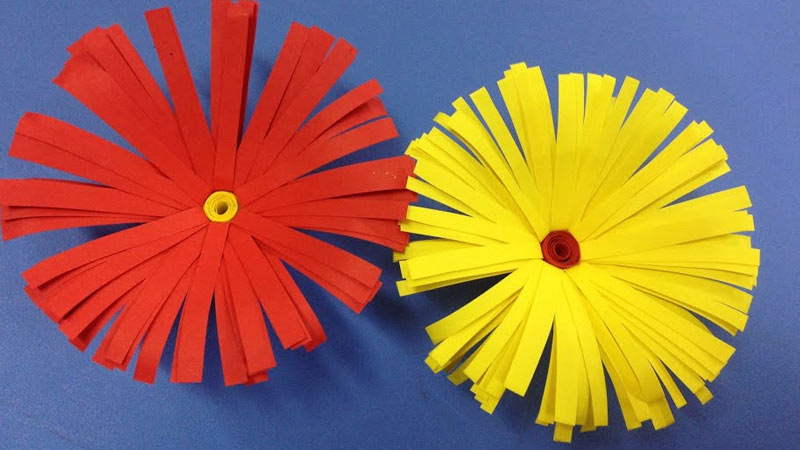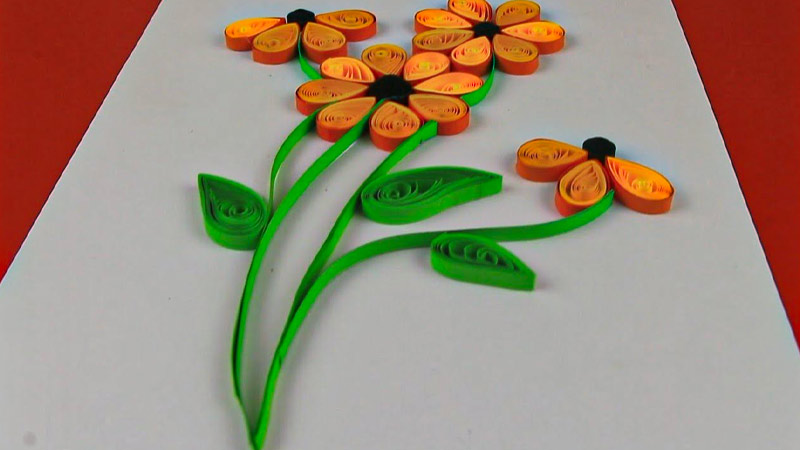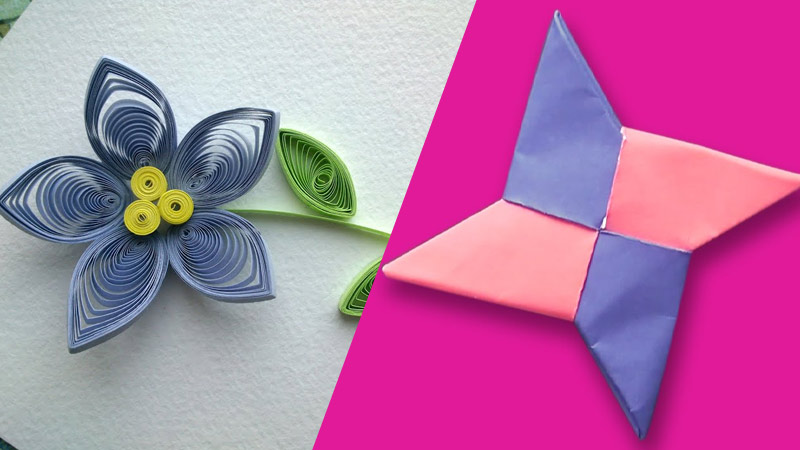Quilling and origami are both captivating paper arts, each with its unique techniques and aesthetics. While they share a common medium – paper – they are distinct in their approach and execution.
Origami, rooted in Japanese tradition, involves intricate folding to create intricate three-dimensional sculptures without cutting or gluing.
In contrast, quilling, originating in Europe, focuses on rolling and shaping paper strips to craft decorative designs and patterns, often with adhesive.
While both quilling and origami showcase the incredible versatility of paper as an artistic medium, they diverge in methodology and cultural origins.
This exploration will delve into the characteristics, distinctions, and creative possibilities of these two captivating paper crafts.

What Is Quilling And Origami?
Quilling
Quilling is a creative and decorative paper craft that involves rolling, shaping, and arranging thin strips of paper into intricate designs and patterns.
It is a centuries-old art form that has evolved from its historical roots in Europe to become a popular hobby and artistic expression worldwide.
To create quilled artwork, one typically uses specialized tools like a quilling needle or slotted tool to coil paper strips, which can vary in width and color.
These coils are then glued together to form various shapes, such as flowers, animals, abstract designs, or even intricate portraits.
Quillers can combine different techniques like tight coils, loose coils, and scrolls to add depth and texture to their creations.
Quilling offers endless creative possibilities, from delicate greeting cards to intricate framed art pieces.
It’s a versatile and meditative craft that appeals to artists, crafters, and enthusiasts alike, allowing them to transform simple paper into stunning works of art through patience, precision, and imagination.
Origami
Origami is the traditional Japanese art of paper folding. The word “origami” comes from the Japanese words “ori,” which means “folding,” and “kami,” which means “paper.”
In origami, artists use a single sheet of paper to create intricate and often complex three-dimensional objects and sculptures through a series of precise folds and creases, without cutting or using adhesive.
Origami emphasizes the transformation of a flat, often square, piece of paper into various shapes, animals, flowers, geometric forms, and more.
The art form requires meticulous attention to detail, patience, and a deep understanding of folding techniques.
Origami has cultural significance in Japan and is associated with concepts of simplicity, elegance, and mindfulness.
Over the years, origami has gained popularity worldwide as a creative and meditative hobby, with artists pushing the boundaries of what can be achieved through paper folding, and creating stunning and intricate works of art.
Is Quilling a Form of Origami?

No, quilling is not considered a form of origami. Quilling and origami are two distinct paper crafting techniques with different origins and methods.
Origami is the traditional Japanese art of folding paper to create various objects and shapes without the use of cutting or adhesive.
It emphasizes the transformation of a single sheet of paper into intricate three-dimensional forms solely through folding techniques.
Quilling, on the other hand, originated in Europe and involves rolling and shaping thin strips of paper to create decorative designs, patterns, and embellishments.
Quilling often requires cutting paper strips and using adhesive to hold the shapes together. It focuses more on creating intricate designs and patterns rather than three-dimensional objects.
While both quilling and origami are creative paper arts, they have distinct techniques, cultural backgrounds, and objectives, making them separate and unique forms of artistic expression.
Difference Between Quilling and Origami

Quilling and origami are two distinct forms of paper art that have captivated people around the world for centuries.
While they both involve the manipulation of paper to create intricate designs, they differ in various aspects, from their techniques to the final results.
Let’s explore the key differences between quilling and origami in the table below:
| Aspect | Quilling | Origami |
| Technique | Involves rolling and shaping thin strips of paper into coils, scrolls, and shapes. | Focuses on folding paper into various geometric forms without cutting or gluing. |
| Tools | Requires quilling paper, quilling tools (needle, slotted tool), and adhesive (usually glue). | Needs only a sheet of paper, and occasionally, precision is enhanced with tools like bone folders. |
| Types of Paper | Specialized quilling paper is often used, which can be purchased pre-cut and in various colors. | Typically uses square sheets of paper, which can be plain or patterned. |
| Complexity | Can create highly intricate and detailed designs with the use of multiple coils and scrolls. | Simplicity and elegance are emphasized, with complex designs achieved through advanced folding techniques. |
| Creativity | Allows for a wide range of creativity in terms of design, color combinations, and 3D effects. | Relies on the folding process for creativity, with limited options for adding details or layers. |
| Gluing/Cutting | Gluing is essential for securing the paper coils in place. Cutting may be required to achieve specific shapes. | No gluing or cutting is involved in traditional origami; everything is done through folding. |
| End Products | Commonly used in crafting decorative items, greeting cards, and jewelry. | Often used for creating sculptures, animals, and objects, as well as for artistic expression. |
| Cultural Significance | Quilling has less cultural significance and is often regarded as a decorative craft. | Origami has deep cultural roots in Japan and is often used in traditional ceremonies and as an art form. |
| Learning Curve | Relatively easier to learn and suitable for beginners. | Can be challenging to master, with varying levels of difficulty. |
| Popularity | Widely popular in the crafting community and often used for DIY projects. | Gained popularity worldwide as an art form and as a mindfulness activity. |
Where Did Quilling Originate?
Quilling, also known as paper filigree, has its origins in Europe, particularly during the Renaissance period.
It is believed to have been practiced by nuns and monks in religious communities, where they used strips of gilded paper from old manuscripts to decorate religious artifacts and documents.
These early quilled designs often adorned religious items, such as reliquaries and illuminated manuscripts, adding intricate embellishments to enhance their beauty.
Over time, quilling spread beyond religious contexts and gained popularity as a decorative art form in the 18th century, particularly among affluent European women.
It became a fashionable pastime, with quilled designs adorning items like picture frames, jewelry boxes, and household decorations.
Today, quilling has evolved into a global craft enjoyed by people of all backgrounds, and it continues to be a popular form of artistic expression and decoration worldwide.
What Is the Hardest Origami Ever?
The Origami Ancient Dragon is the hardest origami design that Satoshi Kamiya has ever folded. It may take around 16 hours to fold this model, but it’s definitely worth the effort.
If you’re up for a challenge, give this origami a try – you might be surprised at how well you do. Don’t be discouraged if your first attempt doesn’t go as planned; there are many variations of this dragon available online for easy reference.
Be sure to share your results with us on social media so other origamists can see what hard work and dedication can achieve.
FAQS
Is quilling considered an ancient art like origami?
Quilling has its historical roots in Europe and was popular during the Renaissance period. While it is a centuries-old art form, it did not originate in the same cultural context as origami, which has ancient Japanese origins.
Can you combine quilling and origami in a single project?
Yes, it’s possible to combine quilling and origami techniques in a creative project.
Are there specific tools required for quilling as opposed to origami?
Yes, quilling typically requires tools like a quilling needle or slotted tool to roll and shape paper strips.
Do quilling and origami have different cultural significance?
Yes, they do. Origami has deep cultural roots in Japan and is often associated with concepts like simplicity, precision, and mindfulness.
Quilling, on the other hand, lacks the same cultural significance and is more associated with decorative arts in Europe.
Can quilling be used to create three-dimensional objects like origami can?
Quilling is primarily a two-dimensional art form, focused on creating flat or lightly textured designs.
To Recap
While both quilling and origami are captivating paper arts that showcase the incredible versatility of paper as a creative medium, they are distinct in their techniques, cultural origins, and artistic objectives.
Origami, deeply rooted in Japanese tradition, emphasizes the transformative power of folding paper into intricate three-dimensional forms, often without cutting or gluing.
In contrast, quilling, with its European origins, centers on rolling and shaping paper strips to craft decorative designs and patterns, frequently using adhesive.
The differences between these two paper crafts highlight the richness of human creativity, demonstrating that even within the same medium, diverse approaches can yield stunning and unique results, making quilling and origami equally fascinating and enriching forms of artistic expression.
Leave a Reply